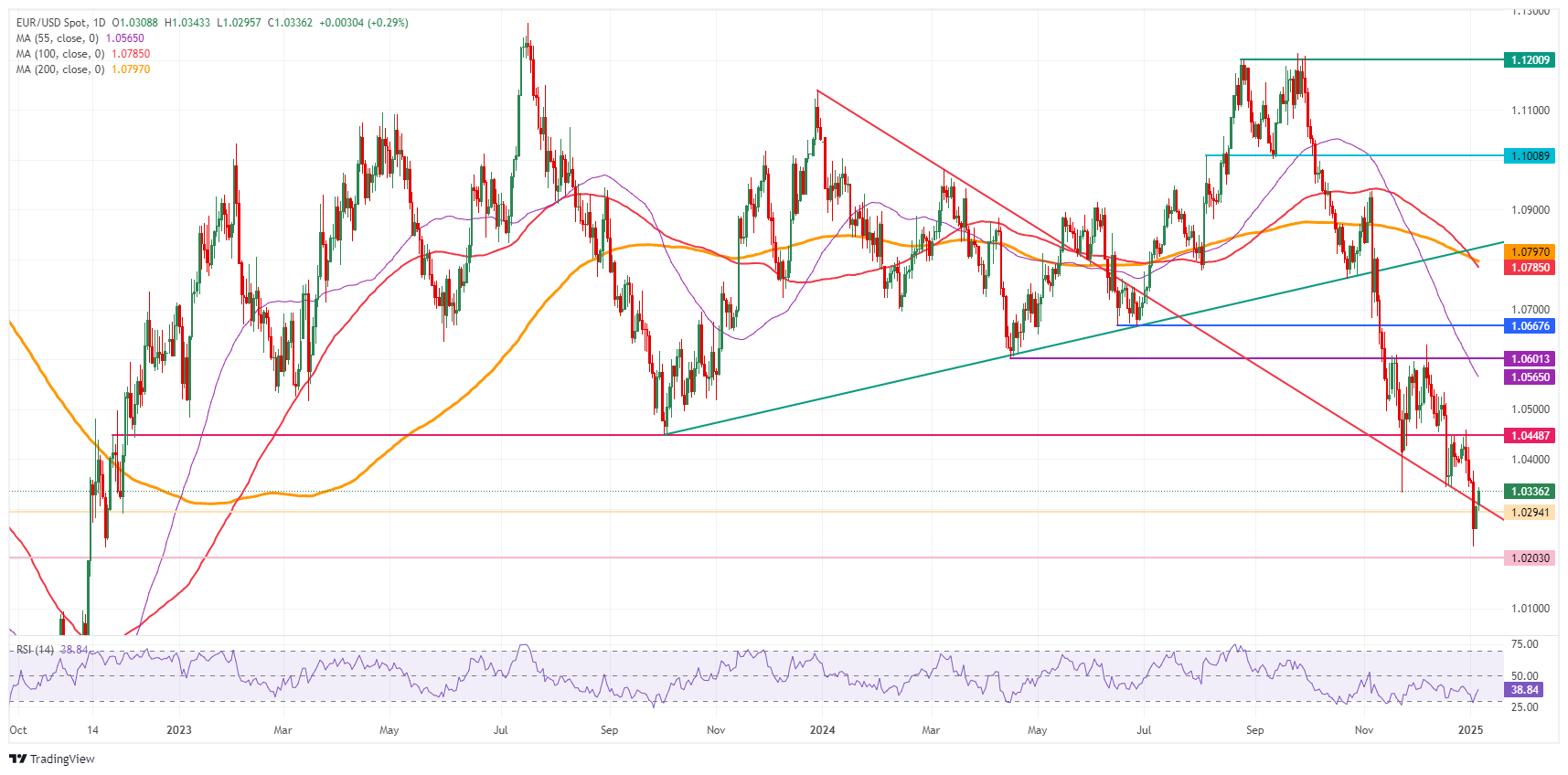Euro extends recovery as markets digest political turmoil
- The Euro bounces further against the US Dollar on Monday after hitting 1.0224 last week.
- Traders assess the impact of the political turmoil in Italy, Austria, and Canada.
- Markets assess European PMI and preliminary Germany’s inflation data for December this Monday.
The Euro is setting forth a second day of recovery and trades above 1.0350 at the time of writing on Monday, heading further away from the fresh 2-year low of 1.0224 seen on Thursday. The positive move is further bolstered by the December Purchasing Managers Index (PMI) releases, with Spanish, Italian, French, German, and the broader Eurozone data recovering from prior month readings and beating expectations.
Markets are also sending the Euro higher due to global political turmoil. Italian Prime Minister Giorgia Meloni broke the unified European ranks by visiting President-elect Donald Trump at Mar-a-Lago, while Canadian Prime Minister Justin Trudeau is set to resign this week, according to Bloomberg News.
Meanwhile, markets are bracing for the first normal trading week of the year regarding the economic calendar. Traders will return to their trading desks, and financial markets are expected to run back to their normal capacity. It is a very packed calendar for both Europe and the US, with the US Nonfarm Payrolls release on Friday as the main focal point for this week.
Daily digest market movers: Euro strikes back
- The Spanish HCOB PMI for the Services sector came in at 57.3, above the 54.1 expected and the 53.1 previous reading.
- The Italian HCOB Services PMI recovered from contraction and came in at 50.7, above the 50.0 estimate and better than the previous 49.2 reading.
- France’s HCOB Services PMI rebounded to 49.3, coming from 48.2 the previous month and beating the estimate of 48.2.
- Germany’s HCOB Services PMI reading came in at 51.6, above the estimate and previous reading of 51.4.
- The German Consumer Price Index (CPI) is set to be released at 13:00 GMT. The December preliminary reading is expected to tick up by 0.4% on a monthly basis compared to the -0.2% in the prior month. The preliminary CPI is expected to rise to 2.4% year-over-year.
- At 14:45 GMT, S&P Global will publish the US Services PMI reading. The final December reading is expected to remain stable at 58.5.
Technical Analysis: EUR/USD tries to head back to 1.04
EUR/USD has seen traders quickly add to their short positions that were unwinded before Christmas, triggering a meltdown to 1.0224 last week. With the oversold Relative Strength Index (RSI), a bounce could unfold to 1.04 or even 1.0448 if the current European data adds to the momentum.
On the upside, the 1.04 big figure is the first level to watch for. Next is the pivotal level at 1.0448, the low of October 3rd, 2023. Once through that level, the 55-day Simple Moving Average (SMA) at 1.0565 comes into play.
On the downside, the current two-year low at 1.0224 is the first support to be retested. Further down, the pivotal level at 1.02 would mean a fresh two-year low. That would open up the room to head to parity, with 1.0100 as the last man standing before that magical 1.00 level.
EUR/USD: Daily Chart
Euro FAQs
The Euro is the currency for the 19 European Union countries that belong to the Eurozone. It is the second most heavily traded currency in the world behind the US Dollar. In 2022, it accounted for 31% of all foreign exchange transactions, with an average daily turnover of over $2.2 trillion a day. EUR/USD is the most heavily traded currency pair in the world, accounting for an estimated 30% off all transactions, followed by EUR/JPY (4%), EUR/GBP (3%) and EUR/AUD (2%).
The European Central Bank (ECB) in Frankfurt, Germany, is the reserve bank for the Eurozone. The ECB sets interest rates and manages monetary policy. The ECB’s primary mandate is to maintain price stability, which means either controlling inflation or stimulating growth. Its primary tool is the raising or lowering of interest rates. Relatively high interest rates – or the expectation of higher rates – will usually benefit the Euro and vice versa. The ECB Governing Council makes monetary policy decisions at meetings held eight times a year. Decisions are made by heads of the Eurozone national banks and six permanent members, including the President of the ECB, Christine Lagarde.
Eurozone inflation data, measured by the Harmonized Index of Consumer Prices (HICP), is an important econometric for the Euro. If inflation rises more than expected, especially if above the ECB’s 2% target, it obliges the ECB to raise interest rates to bring it back under control. Relatively high interest rates compared to its counterparts will usually benefit the Euro, as it makes the region more attractive as a place for global investors to park their money.
Data releases gauge the health of the economy and can impact on the Euro. Indicators such as GDP, Manufacturing and Services PMIs, employment, and consumer sentiment surveys can all influence the direction of the single currency. A strong economy is good for the Euro. Not only does it attract more foreign investment but it may encourage the ECB to put up interest rates, which will directly strengthen the Euro. Otherwise, if economic data is weak, the Euro is likely to fall. Economic data for the four largest economies in the euro area (Germany, France, Italy and Spain) are especially significant, as they account for 75% of the Eurozone’s economy.
Another significant data release for the Euro is the Trade Balance. This indicator measures the difference between what a country earns from its exports and what it spends on imports over a given period. If a country produces highly sought after exports then its currency will gain in value purely from the extra demand created from foreign buyers seeking to purchase these goods. Therefore, a positive net Trade Balance strengthens a currency and vice versa for a negative balance.

